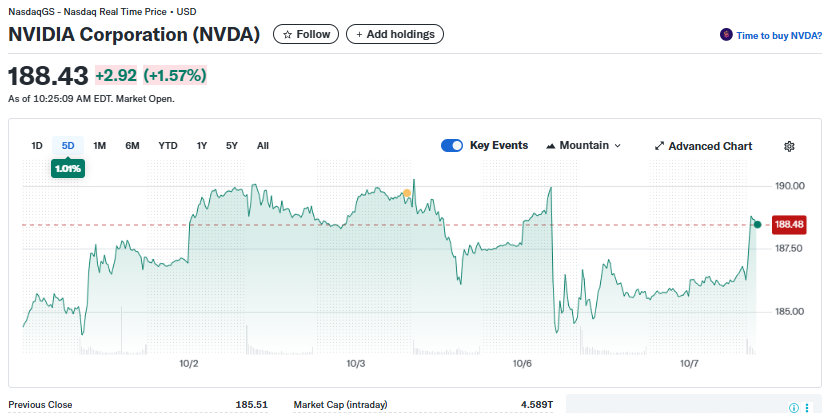TLDRs;
- Nvidia shares rally toward record highs as analysts raise targets amid surging AI chip demand.
- Wall Street eyes $240–$275 price range after Nvidia’s $4 trillion milestone and massive OpenAI partnership.
- Company posts 56% YoY revenue growth as AI spending drives unprecedented demand for its Blackwell GPUs.
- Despite competition from AMD, Nvidia still commands over 90% of the AI accelerator market.
Nvidia Corp. ($NVDA) continues to dominate global markets, with its stock extending a record-breaking rally through early October 2025.
After surpassing a $4 trillion market valuation in September, Nvidia became the most valuable company in the world, eclipsing Apple and Microsoft in the process. On Tuesday, shares traded around $187–$190, tripling the company’s value in just twelve months as investors piled into AI-related stocks.
The meteoric rise to now a $4.58 trillion dollar firm has made Nvidia a symbol of the ongoing artificial intelligence gold rush, as its graphics processing units (GPUs) power everything from generative AI to data center operations. Analysts attribute the company’s exponential growth to soaring chip demand and a dominant position in the AI hardware ecosystem that no rival has yet managed to unseat.

AI Boom Powers Record Revenues
The company’s latest quarterly results reinforced its dominance. Nvidia reported a 56% year-over-year revenue increase, reaching $46.7 billion, and guided toward an estimated $54 billion next quarter. Gross margins remain an industry-leading 72%, highlighting both pricing power and unmatched efficiency.
CEO Jensen Huang credited the company’s new “Blackwell” GPU architecture for the explosive growth, calling demand “extraordinary.” These chips have quickly become the backbone of global AI data centers, driving the infrastructure that powers systems like OpenAI’s ChatGPT and other large language models.
Wall Street has responded enthusiastically. Out of 45 major analysts covering Nvidia, 38 maintain a “Buy” rating. Citigroup recently raised its price target to $210, Barclays to $240, and some ultra-bullish forecasts go as high as $275, implying significant upside potential despite the already historic valuation.
Mega Deals Cement Nvidia’s AI Reign
In late September, Nvidia unveiled a $100 billion strategic partnership with OpenAI, one of the largest corporate technology collaborations in history. The two companies plan to build next-generation AI supercomputers powered by 10 gigawatts of Nvidia hardware, with GPU shipments scheduled to begin in 2026. Nvidia will also make a direct investment in OpenAI, ensuring its deep integration into the AI ecosystem for years to come.
Additionally, Nvidia announced a $5 billion stake in Intel, amounting to roughly 4% ownership, aimed at joint development of next-generation PC and data center chips. The move sent Intel’s stock soaring more than 20%, demonstrating Nvidia’s growing influence across the semiconductor landscape.
Even global tech firms are flocking to Nvidia’s ecosystem, Alibaba recently revealed plans to integrate Nvidia’s AI tools into its cloud platform, sending its own shares up nearly 10%. Together, these alliances underscore Nvidia’s expanding role at the heart of the world’s AI infrastructure.
Rivals Fight Back, But Nvidia Leads
Nvidia’s dominance has forced competitors to react aggressively. On October 6, AMD announced a landmark multi-year AI chip deal with OpenAI, giving the latter an option to take a 10% stake in AMD. That announcement sent AMD’s stock up 24%, while Nvidia’s slipped slightly, an acknowledgment that investors see AMD as a credible challenger in the AI chip space.
However, Nvidia still commands over 90% of the AI accelerator market, bolstered by its CUDA software ecosystem and unmatched developer support. Analysts argue this technological lead will be difficult to erode in the near term.
While some investors have expressed concern over valuation, comparing the current AI euphoria to the dot-com bubble, most agree that Nvidia’s growth trajectory remains robust. Even cautious analysts concede that the company’s end-to-end control of AI hardware, networking, and software makes it a critical infrastructure provider for the AI revolution.






